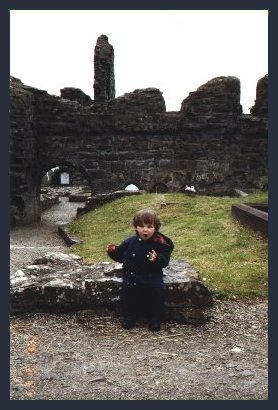|
(Donegal Abbey as seen from the bay)
|
As you enter Donegal Town from the south, a signpost on your left points the way to Donegal Abbey, which was really a Franciscan Friary, and the scanty remains can be inspected down by the shores of the bay. Enough remains of the chapel to allow one to determine that it was a large cruciform building. Of the cloisters, too, there remains a memorial of thirteen arches which, with their supporting couplets of pillars still retain evidence of great beauty and charm and variety of design Insignificant as the ruins are today, they are known and honoured by literary scholars throughout the world. |
|
The Friary was founded in 1475 by Hugh O'Donnell and his wife, Lady Nuala O'Brien and it was at her request that the Franciscans set up a community there. The Friary was destroyed in 1601 by the explosion of several barrels of gunpowder when Hugh Roe O'Donnell was besieging his cousin, Nail Garbh, and an English garrison. Niall didn't get much thanks for deserting to the English (in resentment of Hugh's appointment as Earl of Tyrconnel) for he soon fell out of favour with them and was imprisoned in the Tower of London, where he died in 1629 after a twenty year period of imprisonment. In 1608 the Friary was sacked and abandoned and the holy friars were forced to flee for their lives - it was four of these fleeing monks who were responsible for the most remarkable of all Irish literary works, the renowned Annals of the Four Masters (1632-66). The Four Masters in question were Brothers Michael O'Cleary, Fearfeasa O'Maolconry, Perigrine O'Duignean and Padraig O'Clery. To the memory of these great men there stands, in the Diamond, an oblesk on which their names are inscribed in Irish.
|
|
|
(Main entrance to the Friary) |
(A view of the Friary showing some of the arches in the cloisters (and Liam))
|
|
As you walk through the Friary, you will see some headstones from quite recent years and others buried within the wallsteads. The best time to visit is mid-evening (in the summer) when you can sit at the side of the Friary where it meets the water, and look out over the bay. I found a local and his dog doing just that every time I went there.
|
|
|
(A view of the Friary showing the main part of the building)
|
|



